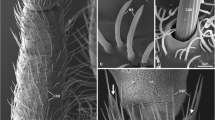Abstract
Spiracles are major respiratory openings in the exoskeleton of insects. Oxygen, a necessary gas for cell activity, must pass through the spiracle to enter the respiratory system. In this study, we investigated the fine structure of spiracles of adult females of Musca domestica L. and Hydrotaea chalcogaster (Wiedemann), both medically important fly species in many parts of the world, by utilizing scanning electron microscopy. The mesothoracic spiracle of M. domestica is large and elongate-oval in shape, with its anterior end being gradually tapered. The outer surface is densely covered with slender setae of variable distribution and orientation. The metathoracic spiracle is semicircular or D-shaped, with its rim possessing long, fine, inwardly curved setae. A net-like valve or sieve plate, which has a smooth rim with swollen surface, is located within the atrium of this species. The abdominal spiracles are circular with a symmetrically swollen peritreme surrounding the opening. The inner filtering apparatus is composed of many spiral tubes, each possessing many small spines. As for H. chalcogaster, the tapering mesothoracic spiracle is covered with long setae arranged consistently inward from the peritreme, giving it a “combed” appearance. The metathoracic spiracle is similarly arranged but triangularly rounded in shape, with the anterior and posterior rims possessing long fine setae. The net-like valve within the atrium has a smooth, swollen rim, whereas the inner edge of the atrium bears short, slender setae where it meets with the peritreme of the spiracle. The abdominal spiracles of this species look similar to that of M. domestica, with the exception of the filtering apparatus that bears only a few small spines. The function of these spiracles is discussed.



Similar content being viewed by others
References
Bohart GE, Gressitt JL (1951) Filth-inhabiting flies of Guam. Bernice P Bishop Mus Bull 204:1–152
Borrer DJ, Triplehorn CA, Johnson NF (1989) An introduction to the study of insects, 6th edn. Saunders College, USA
Carvalho LML, Thyssen PJ, Linhares AX, Palhares FAB (2000) A checklist of arthropods associated with pig carrion and human corpses in Southeastern Brazil. Mem Inst Oswaldo Cruz 95:135–138
Chapman RF (1991) General anatomy and function. In: CSIRO Division of Entomology (ed) The insects of Australia, 2nd edn, vol 1. Melbourne University Press, pp 33–67
Chapman RF (1998) The insects structure and function, 4th edn. Cambridge University Press, UK
Duncan FD, Byrne MJ (2005) The role of the mesothoracic spiracles in respiration in flighted and flightless dung beetle. J Exp Biol 208:907–914
Eisenbeis G, Wichard W (1987) Atlas on the biology of soil arthropods. Springer, Berlin Heidelberg New York
Fernandes FF, Chiarini-Garcia H, Linardi PM (2004) Scanning electron microscopy studies of sensilla and other structures of adult Dermatobia hominis (L. Jr., 1781) (Diptera: Cuterebridae). J Med Entomol 41:552–560
Greenberg B (1971) Flies and disease, vol I. Ecology, classification and biotic associations. Princeton University Press, NJ
Gullan PJ, Cranston PS (2000) The insects. An outline of entomology, 2nd edn. Blackwell Science, UK
Kestler P (1985) Respiration and respiratory water loss. In: Hoffmann K (eds) Environmental physiology and biochemistry of insects. Springer, Berlin Heidelberg New York, pp 137–184
Lehmann FA (2001) Matching spiracle opening to metabolic need during flight in Drosophila. Science 294:1926–1929
Pape T, Arnaud PH Jr (2001) Bezzimyia—a genus of native New World Rhinophoridae (Insecta, Diptera). Zool Scr 30:257–297
Richards OW, Davies RG (1977) Imms’ general textbook of entomology. 10th edn, vol 1. Structure, physiology and development. Chapman and Hall, London
Smith KGV (1986) A manual of forensic entomology. Cornell University Press, NY
Sukontason K, Boonchu M, Khantawa B, Sukontason K, Piangjai S, Choochote W (2000) Musca domestica as a mechanical carrier of bacteria in Chiang Mai, North Thailand. J Vector Ecol 25:114–117
Wasserthal LT (2001) Flight-motor-driven respiratory air flow in the hawkmoth Manduca sexta. J Exp Biol 204:2209–2220
Zumpt F (1965) Myiasis in man and animals in the Old World. Butterworths, London, UK
Acknowledgements
This work received support from the Thailand Research Fund. We thank B. Kuntalue for technical assistance.
Author information
Authors and Affiliations
Corresponding author
Rights and permissions
About this article
Cite this article
Sukontason, K.L., Methanitikorn, R., Boonsriwong, W. et al. Ultrastructure of spiracles of Musca domestica and Hydrotaea chalcogaster (Diptera: Muscidae). Parasitol Res 100, 19–23 (2006). https://doi.org/10.1007/s00436-006-0221-0
Received:
Accepted:
Published:
Issue Date:
DOI: https://doi.org/10.1007/s00436-006-0221-0




